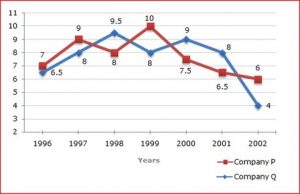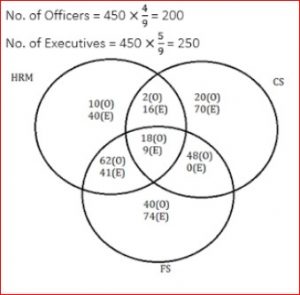A chartered accountancy firm having 450 employees has sent all its employees for training in one or more areas among HRM, Computer skills and Financial skills. The employees are classified into two categories – Officers and Executives – in the ratio of 4 : 5. 10% of the Officers take training only in Computer skills. 16% of the Executives take training only in HRM, which is equal to the number of Officers taking training only in Financial skills. And 40% of the Officers are taking training in HRM and Financial skills both. 6% of the total employees are taking training in all the three areas and of these, two-third are Officers. 10% of the total employees are taking training in HRM and Computer skills both. The number of Officers taking training only in HRM is 25% of the number of Executives taking training only in HRM. 20% of the total number of employees are taking training only in Computer skills. The number of Executives taking training in HRM and Financial skills both is 20% of the total number of Executives. There is no such executive as takes training in both Financial skills and Computer skills but not in HRM. Among the employees who take training in both HRM and Computer skills but not in Financial skills, the ratio of officers to executives is 1 : 8
1)How many Executives are taking training in Financial skills?
a) 124
b) 120
c) Can’t be determined
d) 80
e) None of the above
2)How many Officers are taking training in Computer skills?
a) 22
b) 88
c) 58
d) 40
e) None of the above
3)How many Executives are taking training in HRM but not in Computer skills?
a) 90
b) 106
c) 81
d) 80
e) None of the above
4)What percent of the total number of Officers are taking training in Financial skills but not in HRM?
a) 70%
b) 44%
c) 40%
d) 35%
e) None of the above
5)How many employees are taking training in Financial skills?
a) 280
b) 295
c) 292
d) 287
e) None of the above
Directions: ( 6-10): Two different finance companies declare fixed annual rate of interest on the amounts invested with them by investors. The rate of interest offered by these companies may differ from year to year depending on the variation in the economy of the country and the banks rate of interest. The annual rate of interest offered by the two Companies P and Q over the years is shown by the line graph provided below.

6) A sum of Rs. 4.75 lakhs was invested in Company Q in 1999 for one year. How much more interest would have been earned if the sum was invested in Company P?
a)Rs 19,000
b)Rs.14, 250
c)Rs.11, 750
d)Rs. 9,500
e)None of these
7)If two different amounts in the ratio 8:9 are invested in Companies P and Q respectively in 2002, then the amounts received after one year as interests from Companies P and Q are respectively in the ratio?
a)2:3
b)3:4
c)6:7
d)4:3
e)None of these
8)In 2000, a part of Rs. 30 lakhs was invested in Company P and the rest was invested in Company Q for one year. The total interest received was Rs. 2.43 lakhs. What was the amount invested in Company P?
a)Rs.9 lakh
b)Rs.11 lakh
c)Rs. 12 lakh
d)Rs.18 lakh
e)None of these
9)An investor invested a sum of Rs. 12 lakhs in Company P in 1998. The total amount received after one year was re-invested in the same Company for one more year. The total appreciation received by the investor on his investment was?
a)Rs. 2, 96,200
b)Rs. 2, 42,200
c)Rs. 2, 25,600
d)Rs. 2, 16,000
e)None of these
10)An investor invested Rs. 5 lakhs in Company Q in 1996. After one year, the entire amount along with the interest was transferred as investment to Company P in 1997 for one year. What amount will be received from Company P, by the investor?
a)Rs. 5, 94,550
b)Rs. 5, 80,425
c)Rs. 5, 77,800
d)Rs. 5, 77,500
e)None of these

















